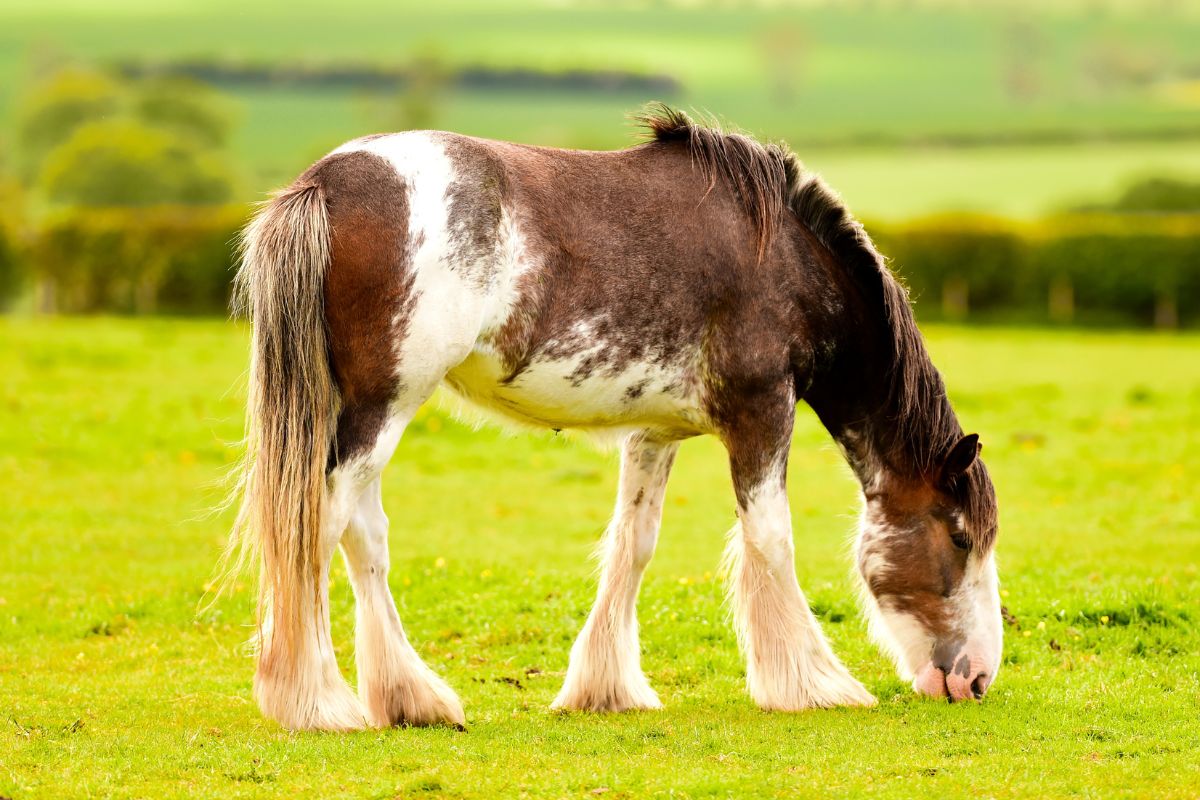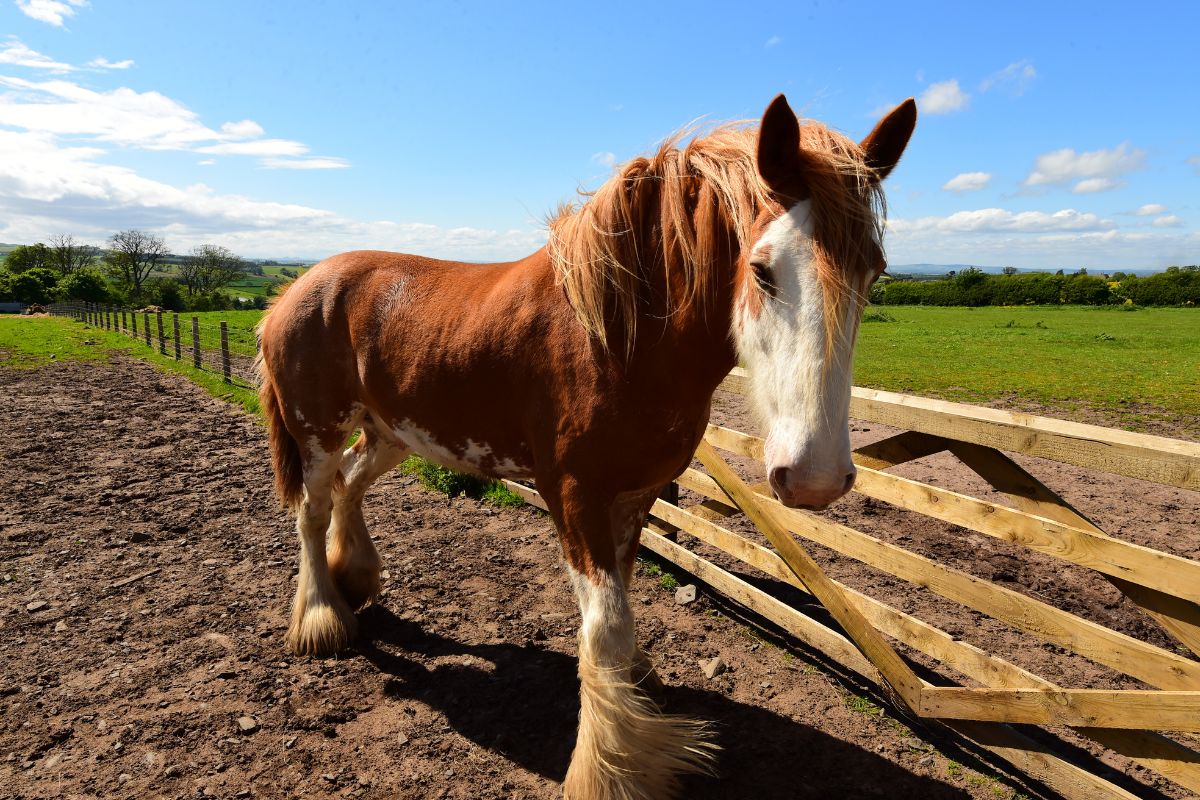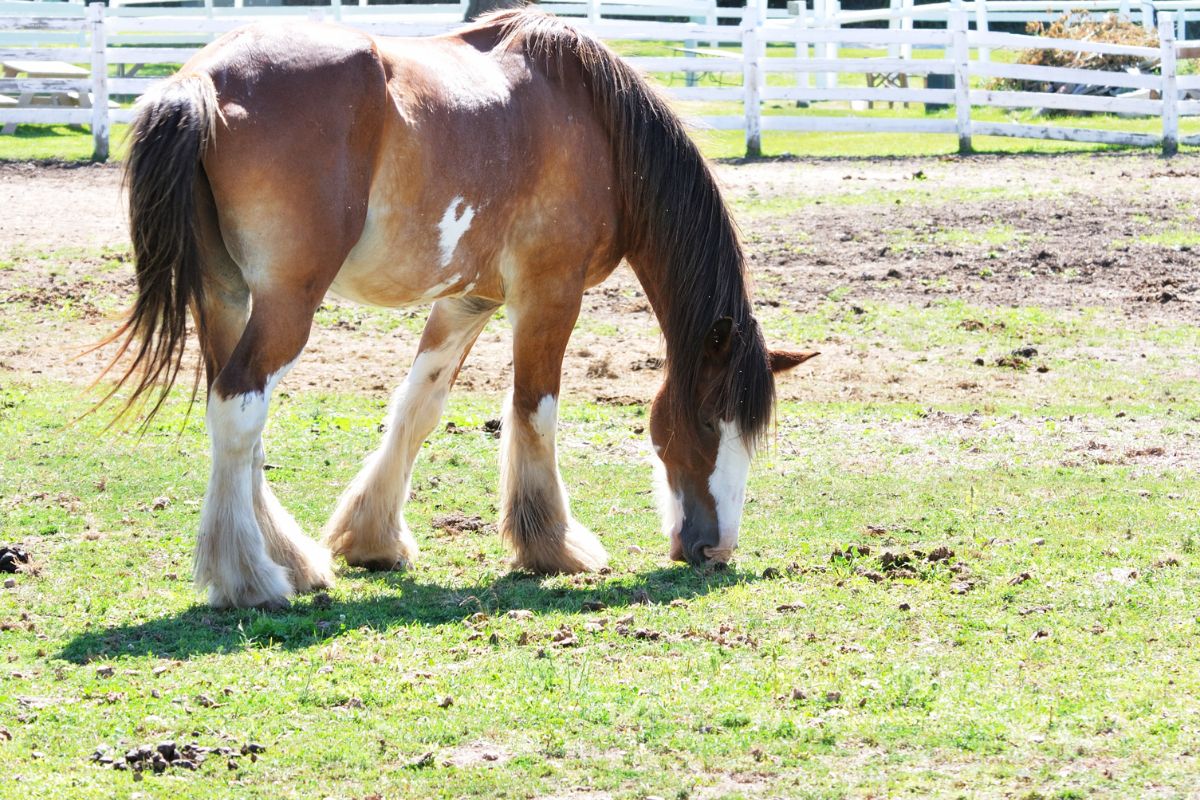What is a Clydesdale Horse
Have you ever wondered how much does a Clydesdale weigh? Before we get into the weight, let’s find out what a Clydesdale horse is.
Clydesdale horses are the most popular horse breed in the United States and were originally bred in Scotland as work animals due to their natural stamina and strength.
The original Clydesdale horse was a cross-breed between British Mares and Flemish stallions but later bred with Shire horses. Read our article and find out Shire Horse vs. Clydesdale – The DIFFERENCE.

How Much Does a Clydesdale Weigh
One of the most common questions about Clydesdales is how much they weigh. A grown stallion usually weighs about 2,000 pounds (907 kilograms), and a mare weighs about 1,650 pounds (748 kilograms). They may weigh even more as they age.
The Clydesdale horse is compact and stocky, with a thicker build than lighter breeds, such as Thoroughbreds or Arabian. The average Clydesdales are heavier than other draft breeds like the Shires or Percherons, which usually weigh between 1,200 to 1,300 pounds (544 to 590 kilograms).
Clydesdale Horse Price
The Clydesdale horse price depends on several factors. The most important of these is the quality of the animal, which is a result of careful breeding. The person selling, whether a dealer or an individual, will also influence the price.
Other aspects that affect the price include
- Bloodlines – A horse from a superior heritage will fetch more money.
- Age – The peak for the breed is five to 14 years, when they will be more expensive when sold.
- Training – A horse trained by a professional will cost more than an untrained horse.
The starting price of a Clydesdale horse is $1,000 up to $5,000. A mature stallion with a good track record as a breeding horse or show horse can fetch as much as $25,000. The prices could be much higher; for example, the highest price for a Clydesdale Horse on record is $212,500.
When buying a Clydesdale horse, you must consider the one-time costs such as transport, stable equipment, rider equipment, and pasture. There are also regular expenses and upkeep for the horse, such as food and water, supplements, bedding, farrier care, boarding, and veterinary and dental care.
A well-trained horse fetches a higher price; therefore, training with a professional trainer will add to the cost of owning a Clydesdale horse.
Clydesdale horses are not as expensive as other breeds, but you can easily recoup the cost of the purchase of the horse by earning money from show wins.
When shopping for a Clydesdale horse, find a good breeder. The quality of the horse’s bloodlines will impact how well the horse performs for you.
Size of Clydesdale Horses
Clydesdales are large horses, and the measurement of horses is in hands and inches. One hand is equal to 4 inches (10 centimeters), so a horse that is 16 hands high is 16 times 4, or 64 inches (163 centimeters) tall, which is about the height of an average adult human.
The Clydesdales horse’s size is usually between 16 and 19.2 hands. This means they are from 64 to 78 inches (163 – 198 centimeters). They often appear larger in photographs because their heavy build and stocky bodies cause them to photograph from above.
Clydesdale Horse Height
The Clydesdale horse size as an adult stallion stands about 32 hands high, about 6 feet (183 centimeters), and 2 inches (5 centimeters) at the withers. A mare is slightly smaller. Both have a bulky appearance with broad shoulders and a strong build.
When people figure out Clydesdale’s height, they usually measure from the ground to the withers. That is the wrong place to measure. The correct place to measure is from the ground to the middle of the knee. This is because the knee is the lowest joint in the leg and most likely where you will be riding the horse.

Clydesdale Horse Coat Color
A typical Clydesdale horse is usually bay or brown, but there is a wide range of variations. It’s not common to see black Clydesdales, gray, or chestnut.
They sometimes have white markings across the body, specifically the face, feet, and legs.
Their muscular necks lead to an arched forehead and alert ear. Their stocky thighs support powerful hindquarters that enable them to pull loads up steep hills or over rough terrain with little difficulty.
Their medium-to-long mane, tail, and feathers on the legs give them a classic look that has never gone out of style among breeders or the general public. Due to their beautiful, sophisticated look, they are primarily used to pull carriages, parades, and shows.
The Clydesdale has two types of hair, fine and long hair on the distinctive coat of the horse and coarser and shorter hair in the form of horsehair. The forehead hair, mane which covers the neck, tail, the tuft of hair at the back of the lower leg, and the white fur around the ankles are called feathers.
The bristles around the muzzle and eyes are king and coarse and are sensitive to touch.
The Different Types of Clydesdale Horse Breeds
The horse categories are three; cold blood, warm blood, and hot blood, which describe the horse’s temperament and bloodline.
Cold blood horses are heavy and have more hair and are referred to as gentle giants due to their having a calm temperament and level-headedness. The Clydesdale are workhorses bred to haul goods in farming and pull heavy carts and farm machinery.
Clydesdale horses are easy to train and give a great show in the ring due to their gentle disposition. Clydesdale horses can pull more than their body weight.
The Clydesdale horse breed is a draft that falls under cold blood. Other types of cold blood horses are Suffolk, Shire, and Belgian.
The warm blood horses, such as Dutch Warmblood and Holsteiner, are a cross breed between cold and hot blood. They are known for their athletic abilities, which is why they are popular in equestrian Olympic sports such as show jumping, dressage, and carriage driving.
Hot blood horses such as Arabian and Thoroughbred have a fierce nature, have higher temperatures than that of an average animal, and have high energy levels. They have increased stamina and endurance capabilities, making them suitable for races.
Hot blood horses are common in polo and horseball. Hot blood horses originate from the Middle East and North Africa.

Conclusion
The Clydesdale horse is a large, powerful breed used to pull carriages and carts for over a century. These draft horses are well-known for their gentle temperament and good breeding record.
The Clydesdales have a compact build and a bay coat with the white Clydesdale feather on the legs, making them stand out from other draft breeds.
The characteristic bay color combined with their compact bodies makes them one of the most attractive draft breeds in North America today.
